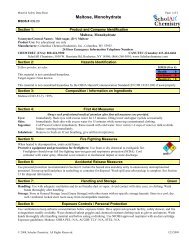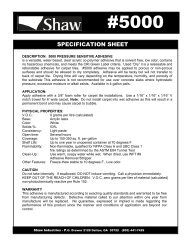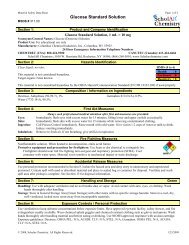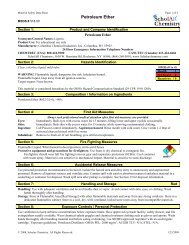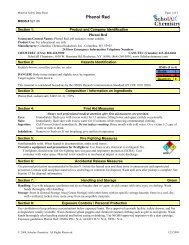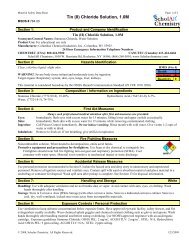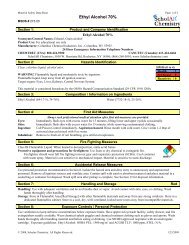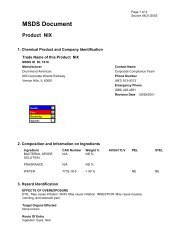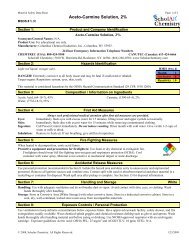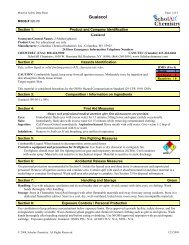Minwax Sanding Sealer.pdf
Minwax Sanding Sealer.pdf
Minwax Sanding Sealer.pdf
Create successful ePaper yourself
Turn your PDF publications into a flip-book with our unique Google optimized e-Paper software.
5600<br />
04 00<br />
MATERIAL SAFETY DATA SHEET<br />
Section 1 -- PRODUCT AND COMPANY IDENTIFICATION<br />
PRODUCT NUMBER DATE OF PREPARATION HMIS CODES<br />
Health 2<br />
5600 19-FEB-08 Flammability 2<br />
Reactivity 1<br />
PRODUCT NAME<br />
MINWAX® <strong>Sanding</strong> <strong>Sealer</strong><br />
MANUFACTURER'S NAME<br />
MINWAX Company<br />
10 Mountainview Road<br />
Upper Saddle River, NJ 07458<br />
TELEPHONE NUMBERS and WEBSITES<br />
Product Information<br />
(800) 523-9299<br />
Regulatory Information<br />
(216) 566-2902 www.paintdocs.com<br />
Medical Emergency<br />
(216) 566-2917<br />
Transportation Emergency for Chemical Emergency ONLY (spill, leak,<br />
(800) 424-9300 fire, exposure, or accident)<br />
Section 2 -- COMPOSITION/INFORMATION ON INGREDIENTS<br />
% by WT CAS No. INGREDIENT UNITS VAPOR PRESSURE<br />
60 64742-88-7 Mineral Spirits<br />
ACGIH TLV 100 ppm 2 mm<br />
OSHA PEL 100 ppm<br />
1 25013-15-4 Vinyl Toluene<br />
ACGIH TLV 50 ppm 1.1 mm<br />
ACGIH TLV 100 ppm STEL<br />
OSHA PEL 100 ppm<br />
Section 3 -- HAZARDS IDENTIFICATION<br />
ROUTES OF EXPOSURE<br />
INHALATION of vapor or spray mist.<br />
EYE or SKIN contact with the product, vapor or spray mist.<br />
EFFECTS OF OVEREXPOSURE<br />
EYES: Irritation.<br />
SKIN: Prolonged or repeated exposure may cause irritation.<br />
INHALATION: Irritation of the upper respiratory system.<br />
May cause nervous system depression. Extreme overexposure may result in<br />
unconsciousness and possibly death.<br />
Prolonged overexposure to solvent ingredients in Section 2 may cause<br />
adverse effects to the liver and urinary systems.<br />
Continued on page 2
5600 page 2<br />
SIGNS AND SYMPTOMS OF OVEREXPOSURE<br />
Headache, dizziness, nausea, and loss of coordination are indications of<br />
excessive exposure to vapors or spray mists.<br />
Redness and itching or burning sensation may indicate eye or excessive<br />
skin exposure.<br />
MEDICAL CONDITIONS AGGRAVATED BY EXPOSURE<br />
None generally recognized.<br />
CANCER INFORMATION<br />
For complete discussion of toxicology data refer to Section 11.<br />
Section 4 -- FIRST AID MEASURES<br />
EYES: Flush eyes with large amounts of water for 15 minutes.<br />
Get medical attention.<br />
SKIN: Wash affected area thoroughly with soap and water.<br />
Remove contaminated clothing and launder before re-use.<br />
INHALATION: If affected, remove from exposure. Restore breathing.<br />
Keep warm and quiet.<br />
INGESTION: Do not induce vomiting.<br />
Get medical attention immediately.<br />
Section 5 -- FIRE FIGHTING MEASURES<br />
FLASH POINT LEL UEL<br />
102 F PMCC 0.9 11.0<br />
FLAMMABILITY CLASSIFICATION<br />
Combustible, Flash above 99 and below 200 F<br />
EXTINGUISHING MEDIA<br />
Carbon Dioxide, Dry Chemical, Foam<br />
UNUSUAL FIRE AND EXPLOSION HAZARDS<br />
Closed containers may explode when exposed to extreme heat.<br />
Application to hot surfaces requires special precautions.<br />
During emergency conditions overexposure to decomposition products may<br />
cause a health hazard. Symptoms may not be immediately apparent. Obtain<br />
medical attention.<br />
SPECIAL FIRE FIGHTING PROCEDURES<br />
Full protective equipment including self-contained breathing apparatus<br />
should be used.<br />
Water spray may be ineffective. If water is used, fog nozzles are<br />
preferable. Water may be used to cool closed containers to prevent<br />
pressure build-up and possible autoignition or explosion when exposed to<br />
extreme heat.<br />
Section 6 -- ACCIDENTAL RELEASE MEASURES<br />
STEPS TO BE TAKEN IN CASE MATERIAL IS RELEASED OR SPILLED<br />
Remove all sources of ignition. Ventilate the area.<br />
Remove with inert absorbent.<br />
Continued on page 3
5600 page 3<br />
Section 7 -- HANDLING AND STORAGE<br />
STORAGE CATEGORY<br />
DOL Storage Class II<br />
PRECAUTIONS TO BE TAKEN IN HANDLING AND STORAGE<br />
Contents are COMBUSTIBLE. Keep away from heat and open flame.<br />
Consult NFPA Code. Use approved Bonding and Grounding procedures.<br />
Keep container closed when not in use. Transfer only to approved<br />
containers with complete and appropriate labeling. Do not take internally.<br />
Keep out of the reach of children.<br />
Section 8 -- EXPOSURE CONTROLS/PERSONAL PROTECTION<br />
PRECAUTIONS TO BE TAKEN IN USE<br />
Use only with adequate ventilation.<br />
Avoid contact with skin and eyes. Avoid breathing vapor and spray mist.<br />
Wash hands after using.<br />
This coating may contain materials classified as nuisance particulates<br />
(listed "as Dust" in Section 2) which may be present at hazardous levels<br />
only during sanding or abrading of the dried film. If no specific dusts<br />
are listed in Section 2, the applicable limits for nuisance dusts are ACGIH<br />
TLV 10 mg/m3 (total dust), 3 mg/m3 (respirable fraction), OSHA PEL 15 mg/m3<br />
(total dust), 5 mg/m3 (respirable fraction).<br />
Removal of old paint by sanding, scraping or other means may generate<br />
dust or fumes that contain lead. Exposure to lead dust or fumes may cause<br />
brain damage or other adverse health effects, especially in children or<br />
pregnant women. Controlling exposure to lead or other hazardous substances<br />
requires the use of proper protective equipment, such as a properly fitted<br />
respirator (NIOSH approved) and proper containment and cleanup. For more<br />
information, call the National Lead Information Center at 1-800-424-LEAD<br />
(in US) or contact your local health authority.<br />
VENTILATION<br />
Local exhaust preferable. General exhaust acceptable if the exposure to<br />
materials in Section 2 is maintained below applicable exposure limits.<br />
Refer to OSHA Standards 1910.94, 1910.107, 1910.108.<br />
RESPIRATORY PROTECTION<br />
If personal exposure cannot be controlled below applicable limits by<br />
ventilation, wear a properly fitted organic vapor/particulate respirator<br />
approved by NIOSH/MSHA for protection against materials in Section 2.<br />
When sanding or abrading the dried film, wear a dust/mist respirator<br />
approved by NIOSH/MSHA for dust which may be generated from this product,<br />
underlying paint, or the abrasive.<br />
PROTECTIVE GLOVES<br />
Wear gloves which are recommended by glove supplier for protection<br />
against materials in Section 2.<br />
EYE PROTECTION<br />
Wear safety spectacles with unperforated sideshields.<br />
OTHER PRECAUTIONS<br />
Intentional misuse by deliberately concentrating and inhaling the<br />
contents can be harmful or fatal.<br />
Continued on page 4
5600 page 4<br />
Section 9 -- PHYSICAL AND CHEMICAL PROPERTIES<br />
PRODUCT WEIGHT 7.05 lb/gal 844 g/l<br />
SPECIFIC GRAVITY 0.85<br />
BOILING POINT 300 - 395 F 148 - 201 C<br />
MELTING POINT<br />
Not Available<br />
VOLATILE VOLUME 68 %<br />
EVAPORATION RATE<br />
Slower than ether<br />
VAPOR DENSITY<br />
Heavier than air<br />
SOLUBILITY IN WATER<br />
N.A.<br />
VOLATILE ORGANIC COMPOUNDS (VOC Theoretical - As Packaged)<br />
4.43 lb/gal 530 g/l Less Water and Federally Exempt Solvents<br />
4.43 lb/gal 530 g/l Emitted VOC<br />
Section 10 -- STABILITY AND REACTIVITY<br />
STABILITY -- Stable<br />
CONDITIONS TO AVOID<br />
None known.<br />
INCOMPATIBILITY<br />
None known.<br />
HAZARDOUS DECOMPOSITION PRODUCTS<br />
By fire: Carbon Dioxide, Carbon Monoxide<br />
HAZARDOUS POLYMERIZATION<br />
Will not occur<br />
Section 11 -- TOXICOLOGICAL INFORMATION<br />
CHRONIC HEALTH HAZARDS<br />
No ingredient in this product is an IARC, NTP or OSHA listed carcinogen.<br />
Reports have associated repeated and prolonged overexposure to solvents<br />
with permanent brain and nervous system damage.<br />
TOXICOLOGY DATA<br />
CAS No.<br />
Ingredient Name<br />
64742-88-7 Mineral Spirits<br />
LC50 RAT 4HR Not Available<br />
LD50 RAT Not Available<br />
25013-15-4 Vinyl Toluene<br />
LC50 RAT 4HR Not Available<br />
LD50 RAT 2255 mg/kg<br />
Section 12 -- ECOLOGICAL INFORMATION<br />
ECOTOXICOLOGICAL INFORMATION<br />
No data available.<br />
Continued on page 5
5600 page 5<br />
Section 13 -- DISPOSAL CONSIDERATIONS<br />
WASTE DISPOSAL METHOD<br />
Waste from this product may be hazardous as defined under the Resource<br />
Conservation and Recovery Act (RCRA) 40 CFR 261.<br />
Waste must be tested for ignitability to determine the applicable EPA<br />
hazardous waste numbers.<br />
Incinerate in approved facility. Do not incinerate closed container.<br />
Dispose of in accordance with Federal, State/Provincial, and Local<br />
regulations regarding pollution.<br />
Section 14 -- TRANSPORT INFORMATION<br />
US Ground (DOT)<br />
May be Classed as a Combustible Liquid for U.S. Ground.<br />
UN1263, PAINT RELATED MATERIAL, 3, PG III, (ERG#128)<br />
Bulk Containers may be Shipped as:<br />
UN1263, PAINT RELATED MATERIAL, COMBUSTIBLE LIQUID, PG III, (ERG#128)<br />
Canada (TDG)<br />
May be Classed as a Combustible Liquid for Canadian Ground.<br />
UN1263, PAINT RELATED MATERIAL, CLASS 3, PG III, (ERG#128)<br />
IMO<br />
UN1263, PAINT RELATED MATERIAL, CLASS 3, PG III, (39 C c.c.), EmS F-E,<br />
S-E<br />
Section 15 -- REGULATORY INFORMATION<br />
SARA 313 (40 CFR 372.65C) SUPPLIER NOTIFICATION<br />
CAS No. CHEMICAL/COMPOUND % by WT % Element<br />
No ingredients in this product are subject to SARA 313 (40 CFR 372.65C)<br />
Supplier Notification.<br />
TSCA CERTIFICATION<br />
All chemicals in this product are listed, or are exempt from listing,<br />
on the TSCA Inventory.<br />
Section 16 -- OTHER INFORMATION<br />
This product has been classified in accordance with the hazard criteria<br />
of the Canadian Controlled Products Regulations (CPR) and the MSDS contains<br />
all of the information required by the CPR.<br />
The above information pertains to this product as currently formulated,<br />
and is based on the information available at this time. Addition of<br />
reducers or other additives to this product may substantially alter the<br />
composition and hazards of the product. Since conditions of use are<br />
outside our control, we make no warranties, express or implied, and assume<br />
no liability in connection with any use of this information.



